You're using an outdated browser. Please upgrade to a modern browser for the best experience.

Submitted Successfully!
Thank you for your contribution! You can also upload a video entry or images related to this topic.
For video creation, please contact our Academic Video Service.
| Version | Summary | Created by | Modification | Content Size | Created at | Operation |
|---|---|---|---|---|---|---|
| 1 | Mourad Nachtane | -- | 4258 | 2023-06-26 12:07:40 | | | |
| 2 | Lindsay Dong | Meta information modification | 4258 | 2023-06-27 02:48:13 | | | | |
| 3 | Lindsay Dong | Meta information modification | 4258 | 2023-06-27 02:49:09 | | |
Video Upload Options
We provide professional Academic Video Service to translate complex research into visually appealing presentations. Would you like to try it?
Cite
If you have any further questions, please contact Encyclopedia Editorial Office.
Nachtane, M.; Tarfaoui, M.; Abichou, M.A.; Vetcher, A.; Rouway, M.; Aâmir, A.; Mouadili, H.; Laaouidi, H.; Naanani, H. Artificial Intelligence for Hydrogen Storage Vessels Design. Encyclopedia. Available online: https://encyclopedia.pub/entry/46046 (accessed on 23 December 2025).
Nachtane M, Tarfaoui M, Abichou MA, Vetcher A, Rouway M, Aâmir A, et al. Artificial Intelligence for Hydrogen Storage Vessels Design. Encyclopedia. Available at: https://encyclopedia.pub/entry/46046. Accessed December 23, 2025.
Nachtane, Mourad, Mostapha Tarfaoui, Mohamed Amine Abichou, Alexandre Vetcher, Marwane Rouway, Abdeouhaed Aâmir, Habib Mouadili, Houda Laaouidi, Hassan Naanani. "Artificial Intelligence for Hydrogen Storage Vessels Design" Encyclopedia, https://encyclopedia.pub/entry/46046 (accessed December 23, 2025).
Nachtane, M., Tarfaoui, M., Abichou, M.A., Vetcher, A., Rouway, M., Aâmir, A., Mouadili, H., Laaouidi, H., & Naanani, H. (2023, June 26). Artificial Intelligence for Hydrogen Storage Vessels Design. In Encyclopedia. https://encyclopedia.pub/entry/46046
Nachtane, Mourad, et al. "Artificial Intelligence for Hydrogen Storage Vessels Design." Encyclopedia. Web. 26 June, 2023.
Copy Citation
Hydrogen is a potential candidate to replace fossil fuels for transport applications, with three technologies considered for the onboard storage of hydrogen: storage in the form of a compressed gas, storage as a cryogenic liquid, and storage as a solid. These technologies are now competing to meet the requirements of vehicle manufacturers; each has its own unique challenges that must be understood to direct future research and development efforts.
hydrogen storage
composite materials
transport applications
circular economy
recycling
artificial intelligence
1. Introduction
Fossil fuels threaten the environment because they use natural resources, make greenhouse gases worse, and pollute the air. Cleaner energy is required [1][2][3][4], and hydrogen is a possible solution for transport applications. In addition to enabling the decarbonization of road transportation, hydrogen energy can also significantly reduce local air pollution [5]. Hydrogen is a non-toxic, colorless, and odorless gas with the highest energy density per mass compared to standard fuels, and more crucially, its fuel infrastructure is on par with traditional road fuels [6].
In the past few years, there has been a rise in the number of programs to make hydrogen meet energy and climate goals. Since 2000 [7], 230 projects have been launched worldwide to convert electrical energy to hydrogen. The capital costs of water electrolyzers installed in 2017 and 2018 are about USD 20–30 million annually. Additional investments in storage tanks, refueling infrastructure, pipes, and other equipment will make the total cost of a project even higher. Both alkaline and proton exchange membrane (PEM) electrolyzers are routinely used in these programs, but recent projects have tended to favor PEM, reflecting that many test conditions favor less mature technologies with considerable cost-saving potential.
Solid oxide electrolyzer cells, which promise improved efficiency, are also entering this market. So far, the electrolyzers in these projects have not been more significant than 10 megawatts (MWe) (with modules between 2 and 4 MW), and most of them have been much smaller [8]. A 20 MWE project is now under development, while several project ideas exceed the 100 MWE mark. Several programs have demonstrated hydrogen conversion to synthetic methane, methanol, ammonia, and other hydrogen-based fuels and feedstocks [9].
Hydrogen, however, can be stored in various physical and chemical ways. Three techniques for onboard hydrogen storage in transport vehicles have been considered: storage in compressed gas (35 MPa or 70 MPa), storage as cryogenic liquid (20 K), and solid storage [10]. It is possible to distinguish three prominent families of materials enabling the solid storage of hydrogen: reversible metal hydrides (LaNi5H6, FeTiH2, Mg2NiH4…), complex hydrides (NaAlH4, LiAlH4, NaBH4…), and porous materials such as nanotubes of carbon and zeolites [11]. These technologies are now in competition to meet the requirements of vehicle manufacturers.
Materials science and research on new materials have made it possible for engineers to think about using less common materials in their designs [12][13][14]. Composite materials are gradually being used for more applications in marine, aerospace, automotive, and other industries [15][16][17][18]. Composites offer excellent strength-to-weight ratios, improved thermal and mechanical properties, and many other desirable aspects obtained by combining the different constituent materials [19][20][21][22][23]. Their use in hydrogen storage vessels could increase the efficiency of the system. Hydrogen storage tank design must consider the application, test pressure, the external environment (including potential mechanical effects, chemical degradation, integration, etc.), life cycle, and safety factors defined for stationary and portable applications [24]. Failure modes and operating conditions should also be considered when selecting materials [25][26][27].
Hydrogen vessels often use composite materials as the most mature solution. These tanks are typically made using filament winding processes, which depend highly on the choice of materials. Therefore, researchers have since explored multiple material options for resin matrix systems and liner systems [28]. However, several limiting factors prevent the broader use of composites for producing sophisticated hydrogen storage tanks, including high life cycle costs and poor recyclability. Depending on the tank size and production volume, carbon fiber accounts for approximately 45–80% of the tank cost [29]. Furthermore, the environmental impact of hydrogen mobility should be assessed and compared to that of other modes of transportation, including the recycling of hydrogen system components at the end of their useful lives (fuel cells and tanks, in particular) [30]. To address these issues, thermoplastics appear to offer a promising solution regarding hydrogen compatibility and the demands of mass automotive markets [31]. Nanocomposites have piqued the interest of researchers due to their superior mechanical, electrical, electronic, optical, magnetic, and surface properties [32]. These materials’ high surface area/volume ratio has crucial implications for energy storage. The enormous surface area and the possibility for nanomaterial improvement are essential characteristics of this new class of hydrogen storage materials. Several research investigations have demonstrated the acute effects of nanofillers on tensile characteristics, thermal conductivity, thermal stability, and gas barrier qualities [33][34].
2. Different Types of Hydrogen Storage
Current options for onboard hydrogen storage include compressed hydrogen gas, cryogenic and liquid hydrogen, sorbents, metal hydrides, and chemical hydrides (Figure 1) [35].
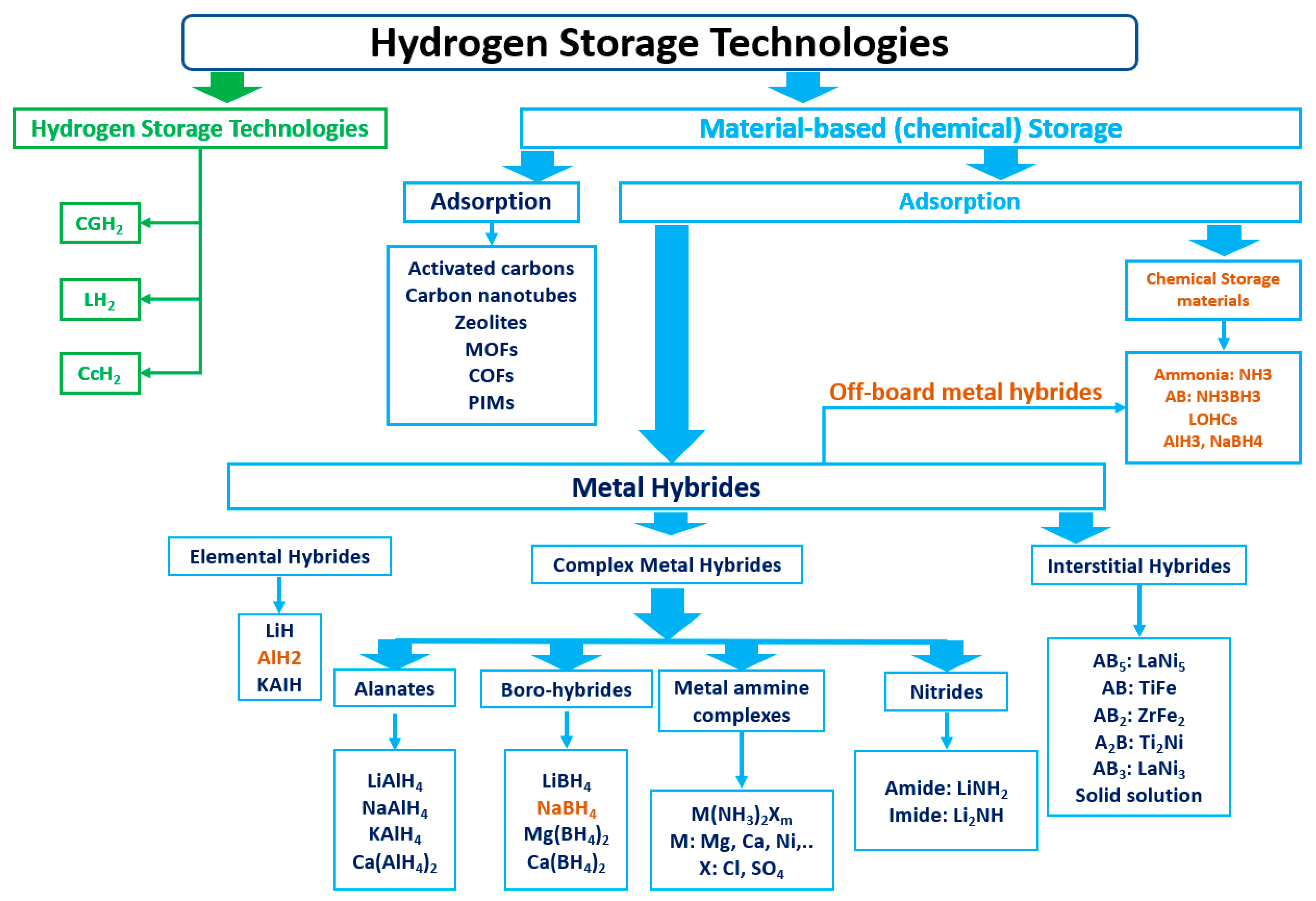
Figure 1. Different types of hydrogen storage [35].
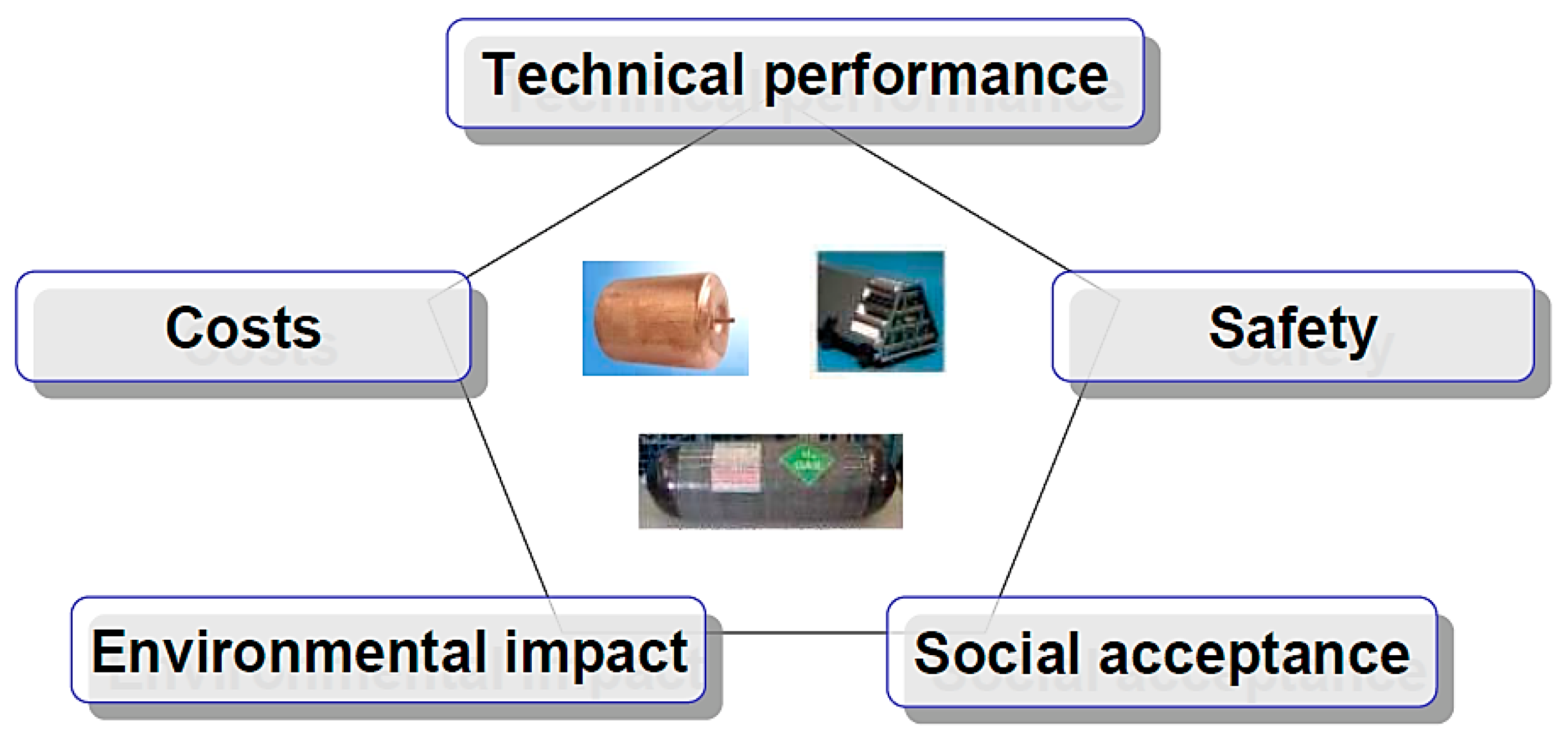
3. Hydrogen Storage Vessels Design
Pressure vessel engineering design approaches have changed throughout time, from approximate calculations using classical laminate theory to thorough finite-element analysis methods that analyze precisely the stresses and strains during various internal and external load circumstances [36]. In order to maximize the amount of H2 that can be stored while staying within the allowed volume range, weight, and maximum operating pressure, hydrogen storage tanks need to be made using complex methods. Material selection is an essential step in the design process. Materials must be hydrogen compatible within the projected boundary conditions, which include exposure level (pressure), mechanical stress levels, temperature extremes, and fatigue loading. Under onboard operation, materials that function well under static load at room temperature may become sensitive to hydrogen embrittlement and time-dependent crack propagation. The reaction to moisture-contaminated hydrogen requires careful study, especially at high temperatures. Hydrogen seals must work reliably at severe temperatures and under numerous pressure cycles and dynamic stresses.
When developing hydrogen storage tanks, five major assessment areas must be considered (Figure 2) [37]. The technical performance of HSVs is a critical factor in determining their effectiveness as a hydrogen storage solution. Several key design elements impact the technical performance of HSVs, including the materials used, the pressure rating, and the size and shape of the vessel. The materials used in the construction of HSVs play a significant role in determining their performance. Steel and aluminum are common materials used in HSV construction due to their strength and durability. However, composite materials, such as fiber-reinforced plastics, are increasingly being used due to their lighter weight and improved resistance to corrosion [38]. The pressure rating of an HSV refers to the maximum pressure that the vessel can safely contain. High-pressure HSVs typically have a pressure rating of 700 bar or more, while low-pressure HSVs have a rating of 350 bar or less. The pressure rating of an HSV will impact its overall storage capacity and efficiency. The size and shape of an HSV can also impact its technical performance. HSVs come in various shapes, including spherical, cylindrical, and toroidal. The shape of an HSV can impact its hydrogen storage capacity and stability, with some shapes providing improved performance over others. Therefore, the cost of manufacturing HSVs can vary greatly depending on the materials used, the design complexity, and the manufacturing process. Steel and aluminum HSVs tend to be less expensive to manufacture than composite HSVs.

Figure 2. Multi-criteria evaluation for hydrogen storage tank design [37].
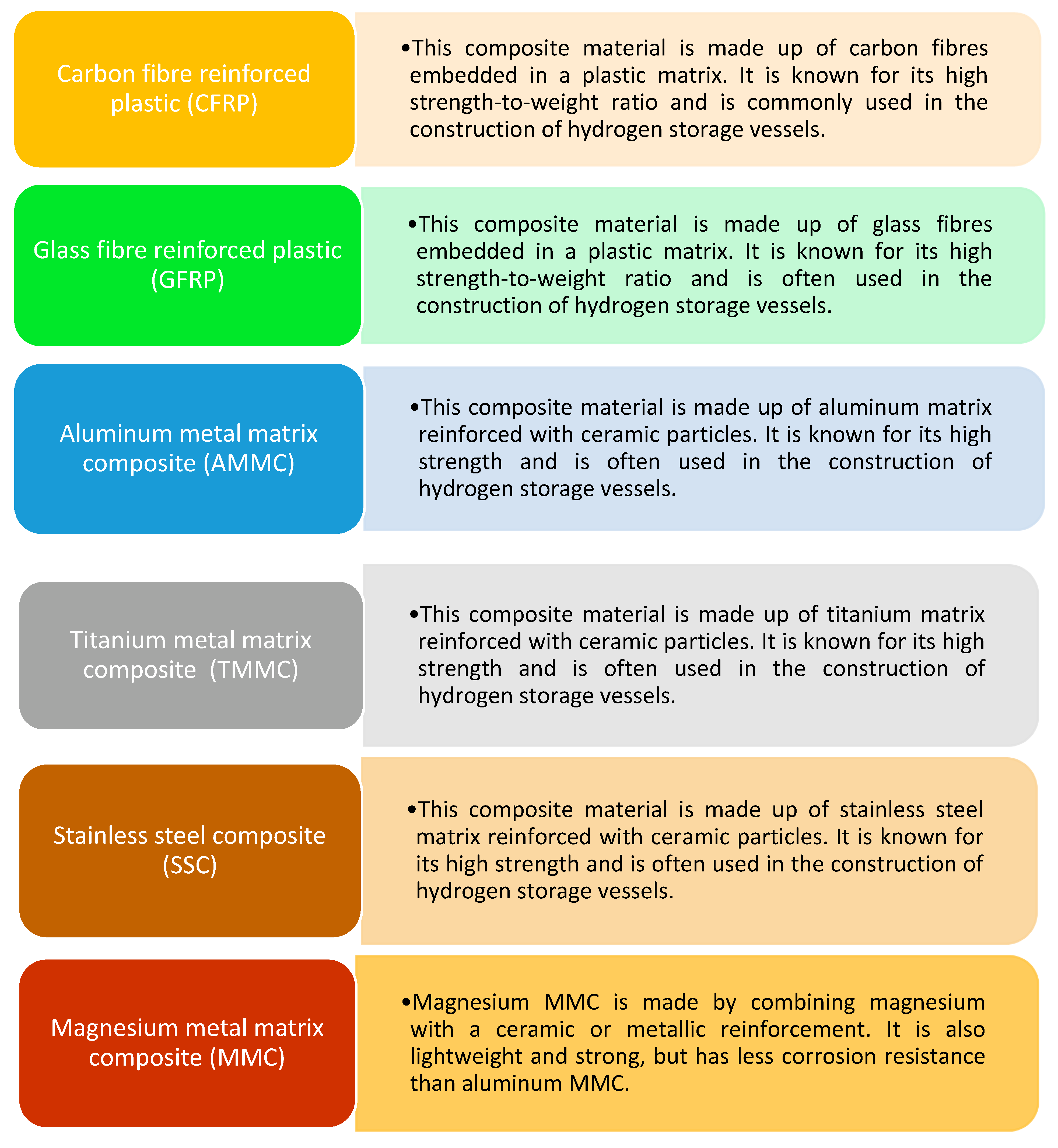
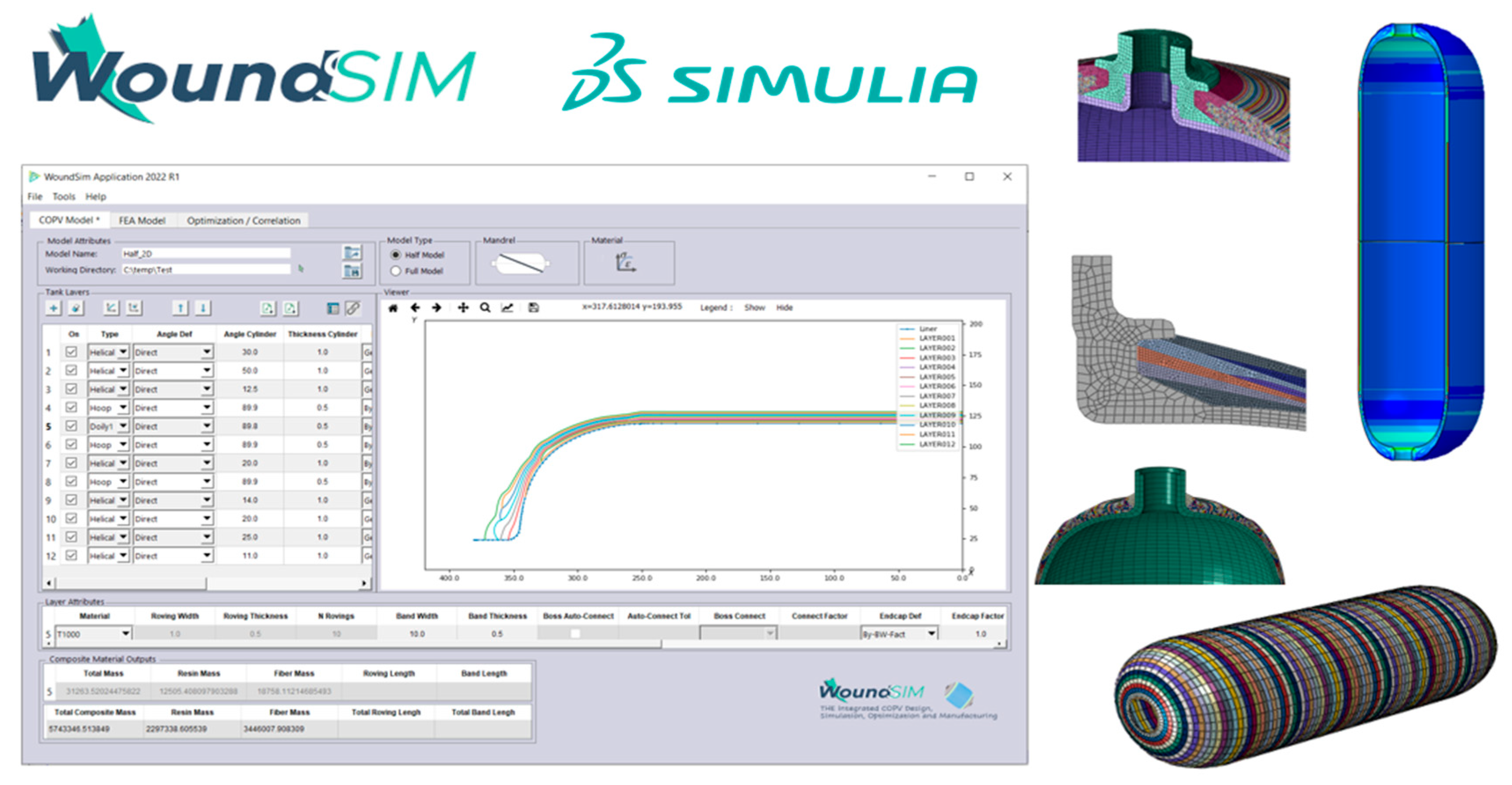
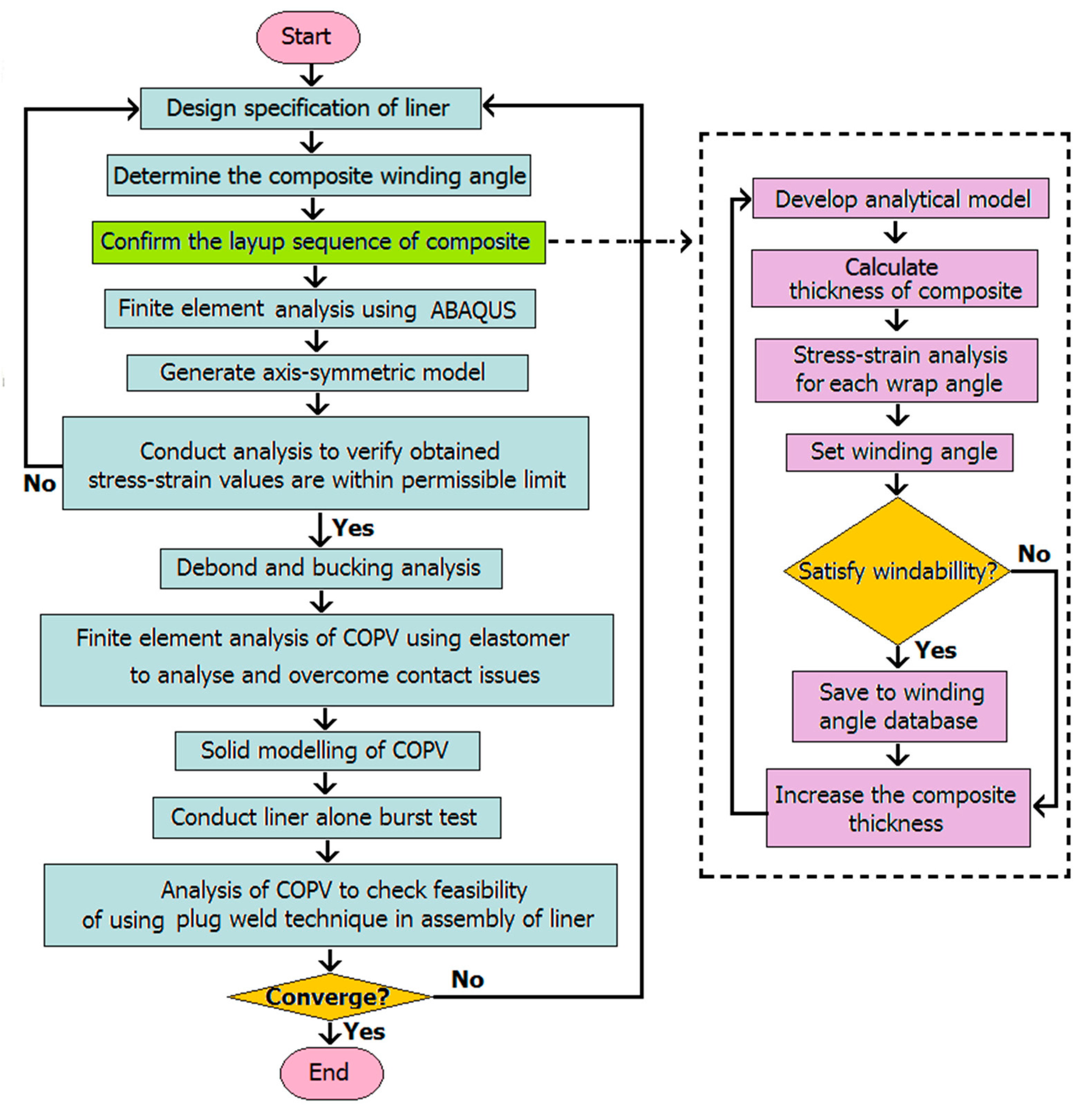
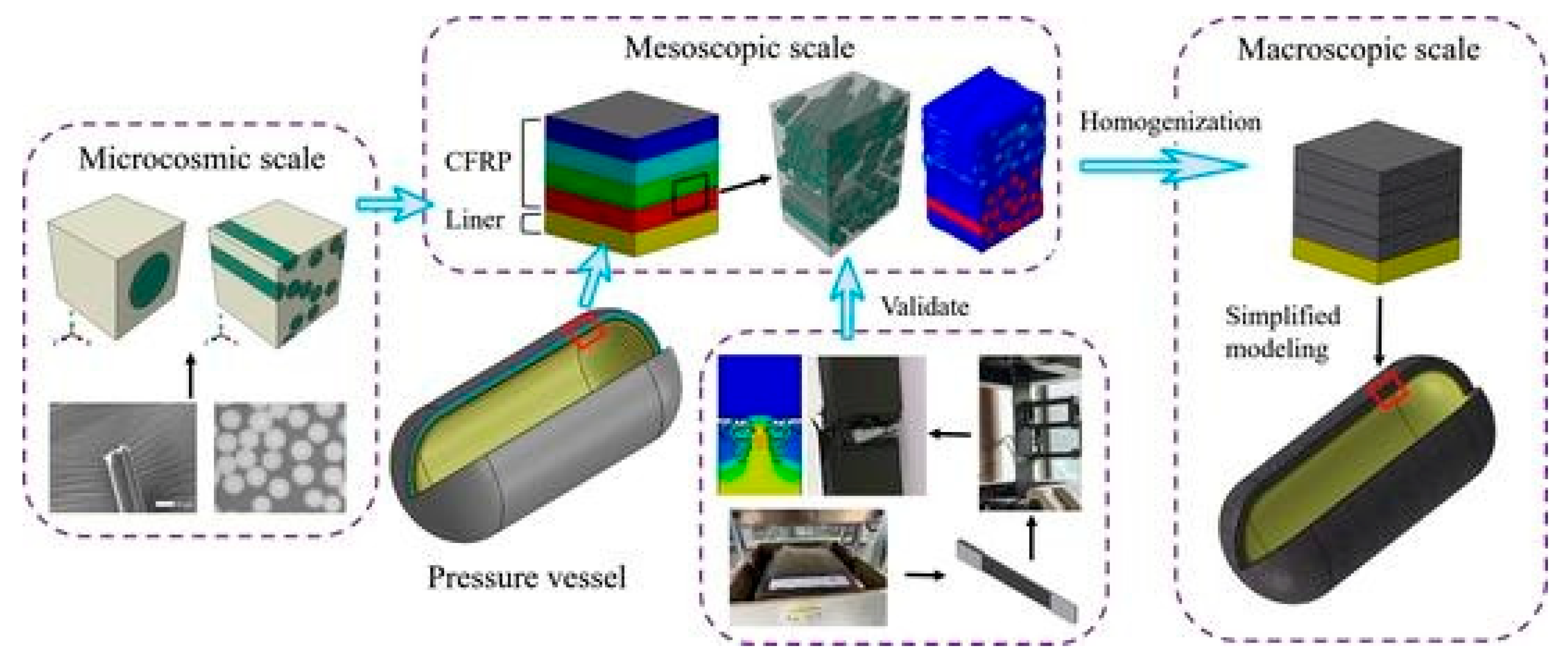
4. Composite Materials for Hydrogen Storage Vessels
Composite materials have been widely studied for use in hydrogen storage vessels due to their high strength-to-weight ratio and excellent resistance to corrosion and fatigue. These materials allow for a lightweight and durable structure that can withstand the high pressure and temperature requirements of hydrogen storage [39]. One of the main benefits of using composite materials for hydrogen storage vessels is their ability to maintain a high level of structural integrity under extreme conditions. These materials have excellent resistance to fatigue and corrosion, which is crucial for the long-term storage of hydrogen. Additionally, composites are highly resistant to impact and thermal cycling, which is vital for safely transporting hydrogen. Another benefit of composite materials for hydrogen storage vessels is their ability to be tailored to specific requirements. Different matrix and reinforcement fiber combinations can achieve specific properties, such as high strength, modulus, or thermal stability. This allows engineers to optimize the design of the storage vessel for specific applications.
Composite materials are also highly cost-effective for hydrogen storage vessels. They are lightweight, which reduces the overall cost of the vessel, and they are also easy to fabricate, reducing manufacturing costs. Additionally, composite materials have a long service life and require minimal maintenance, which further reduces the overall cost of the vessel [40]. Some common materials used in the design of composite hydrogen storage vessels are presented in Figure 3.

Figure 3. Composite materials for hydrogen storage.
This technology requires research and development to reduce costs while improving the performance, dependability, and durability of existing high-pressure vessels. Due to internal pressure, the composite shell can sustain significant mechanical loads.
Carbon fiber type [41]: The type of carbon fiber used for hydrogen storage vessel fabrication can have an impact on the mechanical properties and hydrogen storage capacity of the vessel. Generally, high-strength carbon fibers such as T1000 or higher are preferred for hydrogen storage vessels because they offer superior mechanical properties, such as high tensile strength and stiffness, which are important for withstanding the high pressure and cyclic loading conditions that the vessels may be subjected to during hydrogen storage and transportation. However, the choice of carbon fiber type also depends on the specific application and requirements of the hydrogen storage vessel. For example, if the vessel needs to be lightweight, lower-strength carbon fibers such as T300 or T700 may be suitable. In addition, the manufacturing process and cost of the carbon fibers can also be a consideration.
T300 is the first carbon fiber. It was made by the Japanese company TORAY in the 1970s. It is a standard modulus carbon fiber with a fiber modulus of 33–34 Msi or slightly higher. So, the T300 standard modulus carbon fibers made by Toray are a standard in the industry. T700 is a standard carbon fiber with a high tensile strength and a standard modulus. It is also a standard industrial fiber. From a performance standpoint, carbon fibers T300 and T700 both have a tensile modulus of 230 GPa and a diameter of 7 m. However, T300 has a tensile strength of 3.53 GPa and T700 has a tensile strength of 4.90 GPa. This means that T300’s strength increased by 38.8%, T700’s elongation increased by 40%, and T700’s volume density increased by 2.27%. T800 is an intermediate modulus with a high tensile strength fiber and a tensile modulus of 42 Msi. It has high-level and balanced composite properties.
Because it was the first composite material, T300 carbon fiber has been used a lot for 30 years. At the start, its price was very high. The price of a 400 × 500 × 5 mm carbon fiber sheet of T300 material was between USD 130 and USD 140. However, Toray Corporation began shipping more and more T300, so the cost of the material began to go down. The price of T300 carbon fiber is now very low. A 4,005,005 mm carbon fiber plate costs about USD 80 now, which is almost half of what it cost when it first came out. In terms of price, T700 is about 40% more expensive than T300. A 400 × 500 × 5 mm T700 carbon fiber sheet costs about USD 120, while a T800 sheet costs between 30% and 40% more than a T700 sheet.
T300 is the most common and least expensive type of carbon fiber. Drone fans like T700 because it is a good material. It is used a lot in the drone industry because it is strong and has good value for money. The most expensive is T800 carbon fiber, which is also the strongest. It is mostly used to make high-end products. To make the product lighter as a whole, T800 carbon fiber material must also be used.
Several key considerations must be considered when designing a composite hydrogen storage vessel. Two of the most important considerations are the pressure and temperature requirements of the vessel. Hydrogen storage composite vessels must withstand extremely high pressures, typically 350 to 700 bar, and low temperatures of 20 K without failure or deformation. Another critical consideration is the composite materials’ strength-to-weight ratio [42]. Hydrogen storage vessels must be lightweight and highly durable, and composite materials are an excellent option as they have a high strength-to-weight ratio.
The application of new materials such as graphene and carbon nanotubes (CNTs) is becoming increasingly important for the fabrication of hydrogen storage vessels. These materials have several advantages, including a high surface area for hydrogen adsorption, high strength and stiffness for improved mechanical properties, lightweightedness for reduced weight, flexibility for complex geometries, and scalability for cost-effective production. These advantages can help improve the performance, safety, and cost-effectiveness of hydrogen storage technologies, which are crucial for a sustainable energy future. However, more research is needed to fully understand the properties and behavior of these materials in hydrogen storage applications, as well as their long-term durability and cost-effectiveness.
5. Finite Element Analysis
The analytical design solution for composite hydrogen tanks is based on broad assumptions about load and boundary conditions and does not consider changes in stiffness near the polar boss. To accurately predict how filament wound pressure vessels will behave, finite element analysis (FEA) must be used to model these and other effects correctly. Most filament-wound pressure vessels have first-order non-linear geometry effects that the FEA can only capture. The optimization seeks to increase the composite vessel’s weight, strength, dependability, and service life by designing the wound angles and thickness. As design methods and production technique advance, the composite vessel adopts a lightweight development strategy. Weight reduction has become a method bottleneck that restricts the composite vessel’s economy and practicability. Building a material-structure-processing integrated design and computation methods for composite vessels is imperative in this situation. Other manufacturing and testing factors can affect a composite vessel’s performance; hence the design’s importance may need to be examined.
The finite element analysis has evolved into a potent tool for solving numerical issues associated with complicated structures. Using a combination of continuum damage mechanics (CDM) and FEA, the progressive failure analysis of the composite vessel accounts for the stiffness degradation and predicts the rupture pressure [43]. In particular, the FE approach that implements the damage model has attracted considerable scholarly interest. Several intelligent algorithms that imitate the evolutionary concepts of computational biology, physics, and immunology have been utilized to optimize composite vessels. Genetic algorithms, simulated annealing, and artificial immune system are standard algorithms. Multiple commercial algorithms exist today for generating filament winding pathways, and they all rely heavily on the shape of the mandrel. In order to enhance the final product’s performance, researchers have investigated a more complicated path-generating approach, as detailed in the work presented in [44]. The approach considered the mandrel’s evolving shape due to the ply’s unequal thickness distribution from previous winding processes. The alternative strategy involves using high-tech machinery and paying for commercial software for path creation to arrive at an optimal design for the COPV. Using a simulation tool like WoundSim [45] can help reduce the time and cost of developing composite hydrogen storage tanks, allowing designers to test and optimize their designs without needing physical prototypes (Figure 4). This can be particularly useful when working with composite materials, as these materials can be difficult to work with and require specialized manufacturing processes. Advanced features like optimization, parametric design, and creation of experiments are available in WoundSIM. The translation efficiency in FEA is defined as the ratio of the observed failure strain to the theoretical composite tensile strain. The model’s fiber quality, winding method, manufacturing process, and actual structure vary (e.g., voids, fiber misalignment, resin pockets, etc.). Each tank maker has varied translation efficiency, discovered via experience. The FEA model must be calibrated to obtain translation efficiency and account for the abovementioned changes. WoundSim is a set of comprehensive features that ensure a rapid design and simulation of pressure vessels. Overall, using simulation tools like WoundSim is an important part of the hydrogen storage vessels industry, allowing designers to create more efficient and effective products using advanced materials. The main features are listed below:

Figure 4. WoundSIM software [45].
-
A democratized tool with a comprehensive and standalone user interface.
-
User interface short time response, which accelerates design duration.
-
Comprehensive and well-chosen design parameters allow a quick variation of the layers’ shape.
-
Fully automated FEA model generation, allowing performing simulations with minimum FE knowledge.
-
Winding problems anticipation.
-
Smart layup rendering allows layer selection and intersection detection.
-
Design of experiment capabilities for parametric design optimization.
-
Full compatibility with ABAQUS software and no need for a FORTRAN compiler to post-process specific material outputs.
-
Compatibility with filament winding software.
-
Models calibration and correlation with produced reservoir measurements.
5.1. Multi-Scale Modeling of Composite Hydrogen Storage Vessels
Multi-scale modeling of composite hydrogen storage vessels involves using mathematical models and simulation tools to analyze the performance of these vessels at different scales (Figure 5). This analysis can include modeling the behavior of individual materials and components at the microscale and predicting the vessel’s overall performance at the macroscale [46][47][48][49]. Multi-scale modeling is useful for understanding the complex interactions within composite hydrogen storage vessels and identifying the factors influencing their performance. It can also be used to optimize the design and construction of these vessels by identifying the materials and techniques that result in the best performance. To perform multi-scale modeling of composite hydrogen storage vessels, researchers may use software such as ABAQUS or ANSYS (Figure 6) and specialized modeling and simulation tools designed for this purpose [48]. They may also use experimental data from tests and simulations to validate and refine their models. Overall, the goal of multi-scale modeling is to develop a better understanding of the behavior of composite hydrogen storage vessels and improve their performance.

Figure 5. Flow chart of finite element modeling of a composite vessel [50].

Figure 6. Multiscale study of CFRP pressure vessel [48].
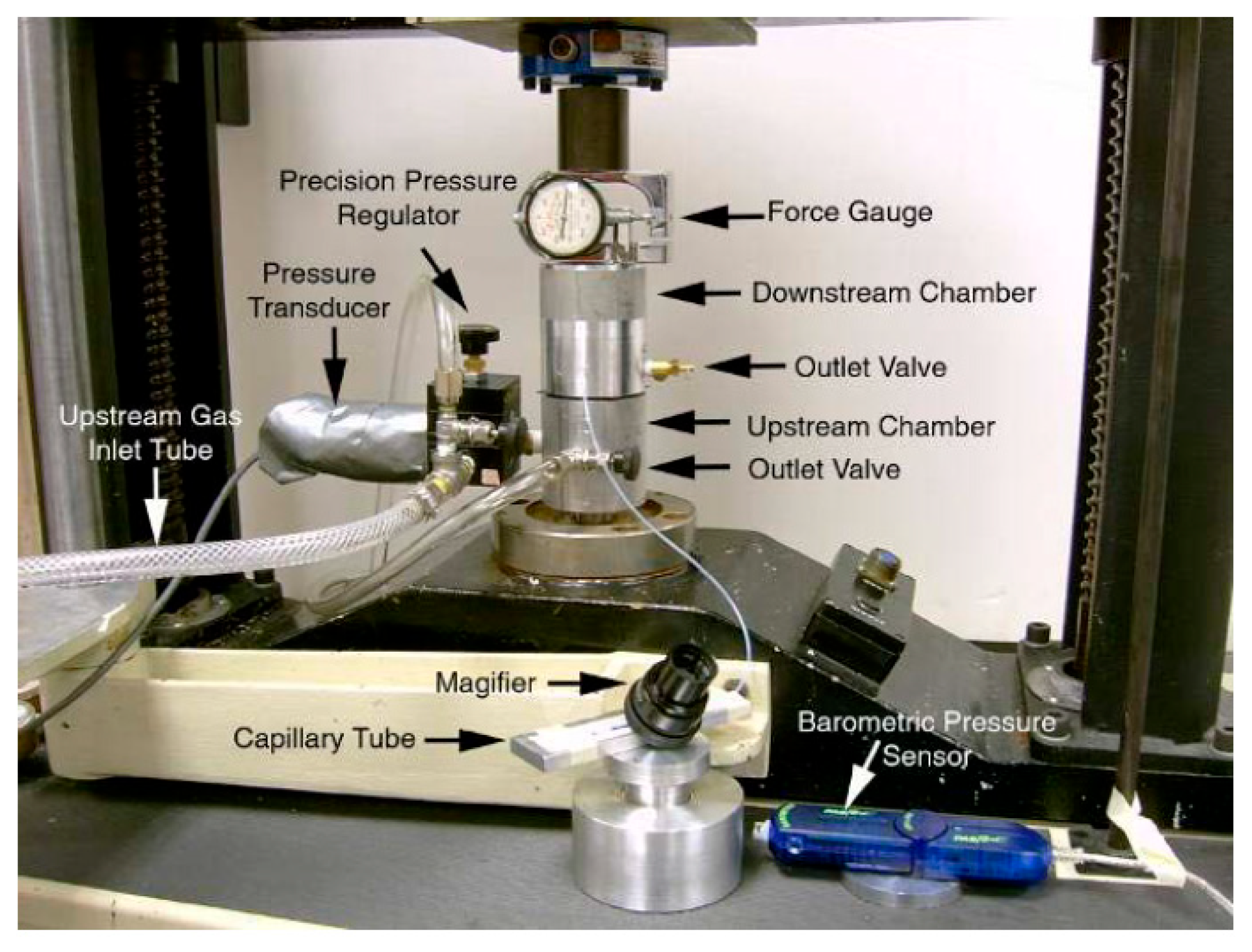
5.2. Development of Test Procedures for C-H2 Vessels: Impact Test/Static Fatigue
Hydrogen permeability in carbon fiber composite structures is important when designing hydrogen storage vessels. Hydrogen permeability refers to the ability of hydrogen atoms to pass through a material and is a measure of the material’s gas transmission rate [51]. The permeability of hydrogen in carbon fiber composite structures can vary depending on the specific composite material used, the thickness of the material, and the temperature and pressure conditions. Carbon fiber composite materials generally have low permeability to hydrogen, making them suitable for use in hydrogen storage vessels. The permeability of hydrogen in the inner and outer vessels of a composite hydrogen storage vessel can also vary depending on the specific materials and design of these vessels. The inner vessel, typically designed to hold the hydrogen gas, may have a higher permeability than the outer vessel, which is designed to provide structural support and protect the inner vessel from external factors such as impact and temperature fluctuations (Figure 7).

Figure 7. Permeability Test Facility [52].
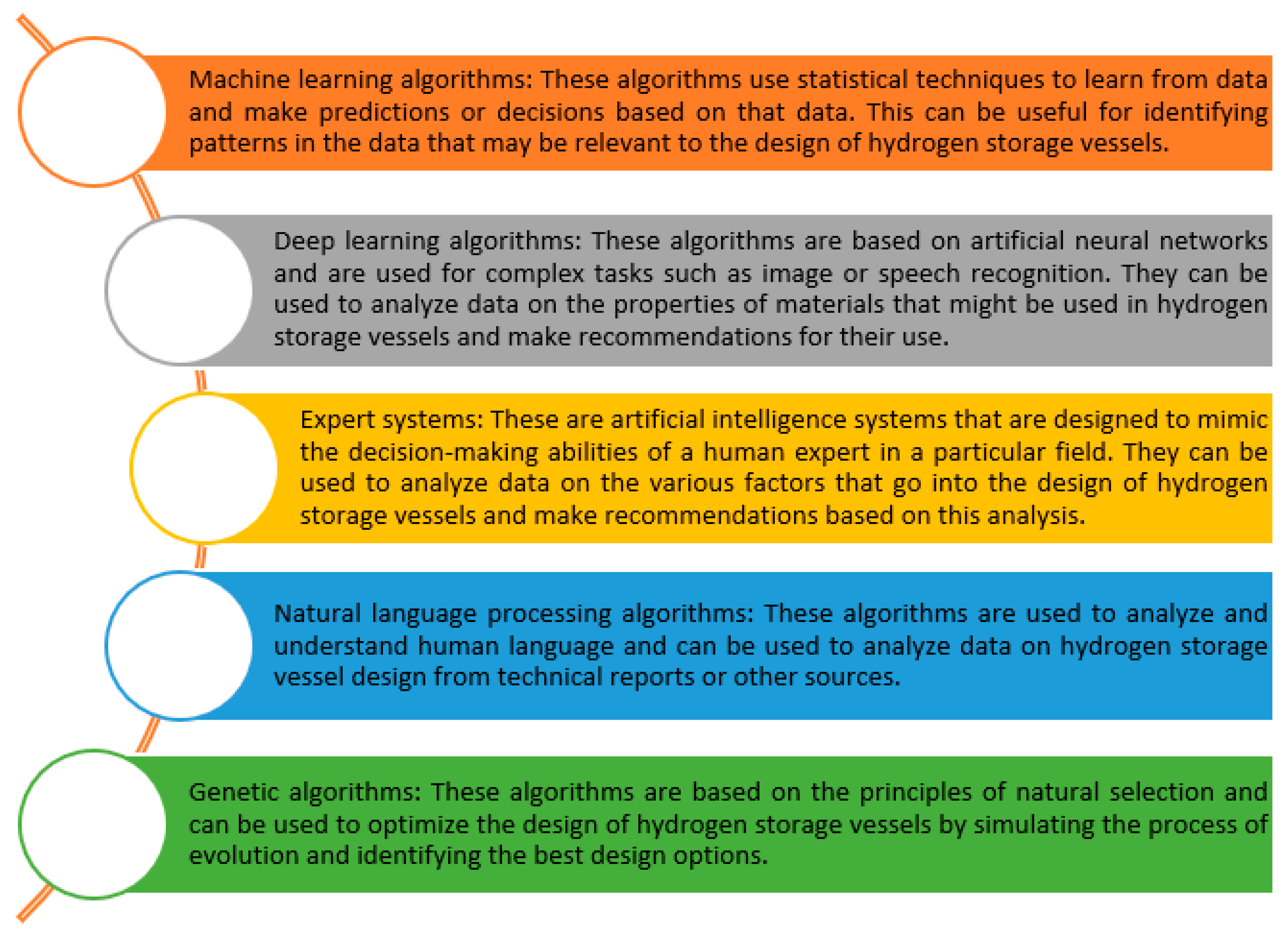
6. Artificial Intelligence and Optimization Models for Hydrogen Storage Vessels Design
Artificial intelligence (AI) is increasingly being used to improve the design and performance of hydrogen storage vessels [53]. AI can analyze large amounts of data and identify patterns and relationships that can help optimize the design of the vessels and improve their safety and performance. In addition, the use of AI in the design and optimization of composite storage vessels has the potential to improve these systems’ performance, safety, and sustainability. By automating many of the manual and time-consuming tasks associated with design and analysis, AI can help accelerate the development of effective and efficient composite storage solutions. Several artificial intelligence models can be used to design hydrogen storage vessels (Figure 8).

Figure 8. Types of artificial intelligence models used for the design of hydrogen storage vessels.
Machine learning models can be trained on data from experiments or simulations to identify materials that have desirable properties, such as high hydrogen storage capacity, low weight, or high strength. By using machine learning to guide the selection of materials, researchers can more quickly and efficiently identify promising candidates for use in hydrogen storage systems. Another area of research involves the use of reinforcement learning to optimize the design of hydrogen storage vessels. Reinforcement learning involves training a machine learning model to learn from feedback received based on its actions, with the goal of maximizing a specific reward function. In the context of hydrogen storage vessel design, this could involve optimizing the geometry, material properties, or other design parameters of the vessel to maximize hydrogen storage capacity or minimize weight. The source of the training set for hydrogen storage vessel design will depend on the specific problem statement and available data. In general, the training set can be sourced from experimental or simulation data, or from existing datasets in the literature or industry. If experimental data is available, it can be used to train a machine learning model to predict the behavior of hydrogen storage vessels under different conditions. This can involve testing the vessels under a range of pressures, temperatures, and other relevant variables, and collecting data on their performance.
An objective function is required to optimize a composite pressure vessel [54]. This function must represent the performance of the composite material, and in some instances, local minima may exist. This objective function is utilized by optimization techniques to discover the optimal solution. In general, these methods can be divided into two categories: those that require simple function evaluations and those that require the computation of gradients. Due to the complexity of the mechanical behavior of composite materials, gradient calculation may be tricky. Gradient-based approaches are, therefore, ineffectual when several design variables are present and may result in a local minimum, rendering them untrustworthy.
The ML algorithm derives a function from training data and maps it onto new output data. Regression and classification issues are characterized as supervised learning challenges. Regression is concerned with quantitative labeling, such as estimating the number of instances of an object in a given image. Classification is concerned with qualitative data, such as indicating whether an image is of a specific type. Linear regression, logistic regression, neural networks, multilayer perceptron, support vector machines, naive Bayes, decision trees, and the K-nearest neighbor algorithm are the most prominent learning algorithms.
The development of a digital twin for a composite hydrogen storage vessel involves creating a computational model that can predict the behavior and performance of the physical vessel, without requiring the need for expensive and time-consuming full-scale prototyping and testing. The digital twin uses available information and data to accurately forecast the future performance of the hydrogen storage vessel. This approach can help optimize the design and performance of the hydrogen storage vessel, ensuring its safety and reliability. Burov and Burova (2020) [55] focused on the development of a digital twin for a composite overwrapped pressure vessel (COPV) commonly used in electric propulsion engines for spacecraft. The purpose of the digital twin was to accurately predict the future behavior and performance of the physical COPV, without the need for expensive and time-consuming full-scale prototyping and testing.
7. Summary
Composite materials, such as carbon fiber reinforced polymer (CFRP), are increasingly being used in the construction of hydrogen storage vessels due to their lightweight, high-strength, and corrosion-resistant properties. However, designing and testing these vessels can be expensive and time-consuming, making it difficult to quickly iterate and improve upon designs. Artificial intelligence (AI) is another important area of research in hydrogen storage vessel design. AI algorithms can be used to analyze large amounts of data collected from sensors on a hydrogen storage vessel, allowing engineers to identify patterns and optimize the design and operation of the vessel. This is where digital twin technology comes in. A digital twin is a virtual model of a physical object or system that uses real-time data and simulations to predict its behavior and performance. By creating a digital twin of a hydrogen storage vessel, engineers can test and optimize designs in a virtual environment before building a physical prototype. This can significantly reduce the cost and time required for design and testing.
While hydrogen storage vessels made of composite materials offer many advantages over traditional metal vessels, there are still some challenges that need to be addressed. For example, composite materials have different failure modes than metals, and predicting their behavior under different loading conditions can be challenging.
There are also some potential disadvantages of using artificial intelligence (AI) and digital twin technology in the development of hydrogen storage vessels. One potential disadvantage is that the use of AI requires large amounts of data, and the quality and accuracy of the data can greatly affect the reliability and effectiveness of the AI model. This can be a challenge in the case of hydrogen storage vessels, where data on their behavior and performance may be limited and difficult to obtain. Another disadvantage is the potential for the AI model to be biased, either due to the quality of the data used or due to the inherent biases of the AI algorithms themselves. This can lead to inaccurate predictions or recommendations, and could have serious consequences in the case of safety-critical systems such as hydrogen storage vessels. Additionally, digital twin technology requires significant computational resources to simulate the behavior and performance of the physical system in real time. This can be a challenge for industrial applications, where real-time performance is critical and there may be limited resources available for computing. Finally, there is the risk of cyber attacks on the digital twin system, which could compromise the safety and security of the physical system it is modeling. It is important to implement strong cybersecurity measures to protect against these risks.
References
- Nachtane, M.; Tarfaoui, M.; Goda, I.; Rouway, M. A review on the technologies, design considerations and numerical models of tidal current turbines. Renew. Energy 2020, 157, 1274–1288.
- Nachtane, M.; Tarfaoui, M.; Saifaoui, D.; El Moumen, A.; Hassoon, O.; Benyahia, H. Evaluation of durability of composite materials applied to renewable marine energy: Case of ducted tidal turbine. Energy Rep. 2018, 4, 31–40.
- Nachtane, M.; Tarfaoui, M.; Mohammed, M.A.; Saifaoui, D.; El Moumen, A. Effects of environmental exposure on the mechanical properties of composite tidal current turbine. Renew. Energy 2020, 156, 1132–1145.
- Olabi, A.; Abdelkareem, M.A. Renewable energy and climate change. Renew. Sustain. Energy Rev. 2022, 158, 112111.
- Weger, L.B.; Leitão, J.; Lawrence, M.G. Expected impacts on greenhouse gas and air pollutant emissions due to a possible transition towards a hydrogen economy in German road transport. Int. J. Hydrogen Energy 2021, 46, 5875–5890.
- Foorginezhad, S.; Mohseni-Dargah, M.; Falahati, Z.; Abbassi, R.; Razmjou, A.; Asadnia, M. Sensing advancement towards safety assessment of hydrogen fuel cell vehicles. J. Power Sources 2021, 489, 229450.
- IEA. The Future of Hydrogen, Report Prepared by the IEA for the G20, Japan; Seizing Today’s Opportunities; IEA: Paris, France, 2019.
- Yue, M.; Lambert, H.; Pahon, E.; Roche, R.; Jemei, S.; Hissel, D. Hydrogen energy systems: A critical review of technologies, applications, trends and challenges. Renew. Sustain. Energy Rev. 2021, 146, 111180.
- İnci, M. Future vision of hydrogen fuel cells: A statistical review and research on applications, socio-economic impacts and forecasting prospects. Sustain. Energy Technol. Assess. 2022, 53, 102739.
- Li, M.; Bai, Y.; Zhang, C.; Song, Y.; Jiang, S.; Grouset, D.; Zhang, M. Review on the research of hydrogen storage system fast refueling in fuel cell vehicle. Int. J. Hydrogen Energy 2019, 44, 10677–10693.
- Kommula, N.D.S. Analysis of Performance and Features of Hydrogen as an Energy Carrier. Master’s Thesis, Universita Politechnica delle Marche, Ancona, Italy, 2022.
- Nachtane, M.; Meraghni, F.; Chatzigeorgiou, G.; Harper, L.; Pelascini, F. Multiscale viscoplastic modeling of recycled glass fiber-reinforced thermoplastic composites: Experimental and numerical investigations. Compos. Part B Eng. 2022, 242, 110087.
- Lagdani, O.; Tarfaoui, M.; Rouway, M.; Laaouidi, H.; Sbai, S.J.; Dabachi, M.A.; Aamir, A.; Nachtane, M. Influence of Moisture Diffusion on the Dynamic Compressive Behavior of Glass/Polyester Composite Joints for Marine Engineering Applications. J. Compos. Sci. 2022, 6, 94.
- Tarfaoui, M.; Sassi, S.; Lagdani, O.; Nachtane, M. Strain rate effects on the thermomechanical behavior of glass/polyester composite joints. Polym. Compos. 2021, 43, 36–51.
- Goda, I.; Nachtane, M.; Qureshi, Y.; Benyahia, H.; Tarfaoui, M. COVID-19: Current challenges regarding medical healthcare supplies and their implications on the global additive manufacturing industry. Proc. Inst. Mech. Eng. Part H J. Eng. Med. 2022, 236, 613–627.
- Lagdani, O.; Tarfaoui, M.; Nachtane, M.; Trihi, M.; Laaouidi, H. A numerical investigation of the effects of ice accretion on the aerodynamic and structural behavior of offshore wind turbine blade. Wind. Eng. 2021, 45, 1433–1446.
- Rouway, M.; Nachtane, M.; Tarfaoui, M.; Chakhchaoui, N.; Omari, L.E.H.; Fraija, F.; Cherkaoui, O. 3D printing: Rapid manufacturing of a new small-scale tidal turbine blade. Int. J. Adv. Manuf. Technol. 2021, 115, 61–76.
- Maziz, A.; Tarfaoui, M.; Rechak, S.; Nachtane, M.; Gemi, L. Finite Element Analysis of Impact-Induced Damage in Pressurized Hybrid Composites Pipes. Int. J. Appl. Mech. 2021, 13, 2150074.
- Boudounit, H.; Tarfaoui, M.; Saifaoui, D.; Nachtane, M. Structural analysis of offshore wind turbine blades using finite element method. Wind Eng. 2020, 44, 168–180.
- Laaouidi, H.; Tarfaoui, M.; Nachtane, M.; Trihi, M. Energy absorption characteristics in hybrid composite materials for marine applications under impact loading: Case of tidal current turbine. Int. J. Energy Res. 2021, 45, 5894–5911.
- Laaouidi, H.; Tarfaoui, M.; Nachtane, M.; Trihi, M.; Lagdani, O. A Comprehensive Numerical Investigation on the Mechanical Performance of Hybrid Composite Tidal Current Turbine under Accidental Impact. Int. J. Automot. Mech. Eng. 2020, 17, 8338–8350.
- Nachtane, M.; Tarfaoui, M.; Ledoux, Y.; Khammassi, S.; Leneveu, E.; Pelleter, J. Experimental investigation on the dynamic behavior of 3D printed CF-PEKK composite under cyclic uniaxial compression. Compos. Struct. 2020, 247, 112474.
- Nachtane, M.; Tarfaoui, M.; El Moumen, A.; Saifaoui, D. Numerical investigation of damage progressive in composite tidal turbine for renewable marine energy. In Proceedings of the 2016 International Renewable and Sustainable Energy Conference (IRSEC), Marrakech, Morocco, 14–17 November 2016; pp. 559–563.
- Barthelemy, H.; Weber, M.; Barbier, F. Hydrogen storage: Recent improvements and industrial perspectives. Int. J. Hydrogen Energy 2017, 42, 7254–7262.
- Tarfaoui, M.; El Moumen, A.; Lafdi, K.; Hassoon, O.; Nachtane, M. Inter laminar failure behavior in laminate carbon nanotubes-based polymer composites. J. Compos. Mater. 2018, 52, 3655–3667.
- Tarfaoui, M.; Nachtane, M.; Khadimallah, H.; Saifaoui, D. Simulation of Mechanical Behavior and Damage of a Large Composite Wind Turbine Blade under Critical Loads. Appl. Compos. Mater. 2018, 25, 237–254.
- Zhou, W.; Wang, J.; Pan, Z.-B.; Liu, J.; Ma, L.-H.; Zhou, J.-Y.; Su, Y.-F. Review on optimization design, failure analysis and non-destructive testing of composite hydrogen storage vessel. Int. J. Hydrogen Energy 2022, 47, 38862–38883.
- Tong, L.; Yuan, Y.; Yang, T.; Bénard, P.; Yuan, C.; Xiao, J. Hydrogen release from a metal hydride tank with phase change material jacket and coiled-tube heat exchanger. Int. J. Hydrogen Energy 2021, 46, 32135–32148.
- Zhang, J.; Lin, G.; Vaidya, U.; Wang, H. Past, present and future prospective of global carbon fibre composite developments and applications. Compos. Part B Eng. 2023, 250, 110463.
- Wanniarachchi, S.; Hewage, K.; Wirasinghe, C.; Chhipi-Shrestha, G.; Karunathilake, H.; Sadiq, R. Transforming road freight transportation from fossils to hydrogen: Opportunities and challenges. Int. J. Sustain. Transp. 2022, 1–21.
- Alves, M.P.; Gul, W.; Junior, C.A.C.; Ha, S.K. A Review on Industrial Perspectives and Challenges on Material, Manufacturing, Design and Development of Compressed Hydrogen Storage Tanks for the Transportation Sector. Energies 2022, 15, 5152.
- Sharma, S.; Sudhakara, P.; Omran, A.A.B.; Singh, J.; Ilyas, R.A. Recent Trends and Developments in Conducting Polymer Nanocomposites for Multifunctional Applications. Polymers 2021, 13, 2898.
- Khan, Z.I.; Habib, U.; Mohamad, Z.B.; Bin Rahmat, A.R.; Abdullah, N.A.S.B. Mechanical and thermal properties of sepiolite strengthened thermoplastic polymer nanocomposites: A comprehensive review. Alex. Eng. J. 2022, 61, 975–990.
- El Bahi, A.; Rouway, M.; Tarfaoui, M.; El Moumen, A.; Chakhchaoui, N.; Cherkaoui, O.; Omari, L.E.H. Mechanical Homogenization of Transversely Isotropic CNT/GNP Reinforced Biocomposite for Wind Turbine Blades: Numerical and Analytical Study. J. Compos. Sci. 2023, 7, 29.
- Kaur, M.; Pal, K. Review on hydrogen storage materials and methods from an electrochemical viewpoint. J. Energy Storage 2019, 23, 234–249.
- Cardiff, P.; Karač, A.; De Jaeger, P.; Jasak, H.; Nagy, J.; Ivanković, A.; Tuković, Ž. An open-source finite volume toolbox for solid mechanics and fluid-solid interaction simulations. arXiv 2018, arXiv:1808.10736.
- Afgan, N.H.; Veziroglu, A.; Carvalho, M.G. Multi-criteria evaluation of hydrogen system options. Int. J. Hydrogen Energy 2007, 32, 3183–3193.
- Soliman, M.; Barone, G.; Frangopol, D.M. Fatigue reliability and service life prediction of aluminum naval ship details based on monitoring data. Struct. Health Monit. 2015, 14, 3–19.
- Sapre, S.; Pareek, K.; Vyas, M. Investigation of structural stability of type IV compressed hydrogen storage tank during refueling of fuel cell vehicle. Energy Storage 2020, 2, e150.
- Moradi, R.; Groth, K.M. Hydrogen storage and delivery: Review of the state of the art technologies and risk and reliability analysis. Int. J. Hydrogen Energy 2019, 44, 12254–12269.
- Ogale, A.A.; Zhang, M.; Jin, J. Recent advances in carbon fibers derived from biobased precursors. J. Appl. Polym. Sci. 2016, 133, app.43794.
- Hassan, I.; Ramadan, H.S.; Saleh, M.A.; Hissel, D. Hydrogen storage technologies for stationary and mobile applications: Review, analysis and perspectives. Renew. Sustain. Energy Rev. 2021, 149, 111311.
- Kim, E.-H.; Rim, M.-S.; Lee, I.; Hwang, T.-K. Composite damage model based on continuum damage mechanics and low velocity impact analysis of composite plates. Compos. Struct. 2013, 95, 123–134.
- Andersen, K.E. Optimization of a Low-melting Alloy for Fused Filament Fabrication 2015. Available online: https://summit.sfu.ca/item/15662 (accessed on 10 February 2023).
- Azeem, M.; Ya, H.H.; Alam, M.A.; Kumar, M.; Stabla, P.; Smolnicki, M.; Gemi, L.; Khan, R.; Ahmed, T.; Ma, Q.; et al. Application of Filament Winding Technology in Composite Pressure Vessels and Challenges: A Review. J. Energy Storage 2022, 49, 103468.
- Wang, L.; Zheng, C.; Wei, S.; Wei, Z. Micromechanics-based progressive failure analysis of carbon fiber/epoxy composite vessel under combined internal pressure and thermomechanical loading. Compos. Part B Eng. 2016, 89, 77–84.
- Littlefield, A.; Macri, M.; Smith, L.; Root, J. Multiscale modeling a composite pressure vessel subjected internal pressure. In Proceedings of the CMAX 2018, Dallas, TX, USA, 15–18 October 2018; p. 17.
- Zhang, N.; Gao, S.; Song, M.; Chen, Y.; Zhao, X.; Liang, J.; Feng, J. A Multiscale Study of CFRP Based on Asymptotic Homogenization with Application to Mechanical Analysis of Composite Pressure Vessels. Polymers 2022, 14, 2817.
- Vignoli, L.L.; Savi, M.A. Multiscale Failure Analysis of Cylindrical Composite Pressure Vessel: A Parametric Study. Lat. Am. J. Solids Struct. 2018, 15.
- Wang, L.; Zheng, C.; Luo, H.; Wei, S.; Wei, Z. Continuum damage modeling and progressive failure analysis of carbon fiber/epoxy composite pressure vessel. Compos. Struct. 2015, 134, 475–482.
- Laadel, N.-E.; El Mansori, M.; Kang, N.; Marlin, S.; Boussant-Roux, Y. Permeation barriers for hydrogen embrittlement prevention in metals—A review on mechanisms, materials suitability and efficiency. Int. J. Hydrogen Energy 2022, 47, 32707–32731.
- Sankar, B.; Xu, J.; Pelt, J.V. Lightweight Composite Tanks for Liquid Hydrogen Storage. In Hydrogen Research for Spaceport and Space-Based Applications: NASA CR-2008-215440, Part 3; NASA Glenn Research Center: Cleveland, OH, USA, 2008; pp. 29–77.
- Ma, K.; Xu, L.; Abed, A.M.; Elkamchouchi, D.H.; Khadimallah, M.A.; Ali, H.E.; Algarni, H.; Assilzadeh, H. An artificial intelligence approach study for assessing hydrogen energy materials for energy saving in building. Sustain. Energy Technol. Assess. 2023, 56, 103052.
- Alcántar, V.; Aceves, S.; Ledesma, E.; Aguilera, E. Optimization of Type 4 composite pressure vessels using genetic algorithms and simulated annealing. Int. J. Hydrogen Energy 2017, 42, 15770–15781.
- Burov, A.E.; Burova, O.G. Development of digital twin for composite pressure vessel. J. Phys. Conf. Ser. 2020, 1441, 012133.
More
Information
Subjects:
Engineering, Mechanical
Contributors
MDPI registered users' name will be linked to their SciProfiles pages. To register with us, please refer to https://encyclopedia.pub/register
:
View Times:
2.4K
Revisions:
3 times
(View History)
Update Date:
27 Jun 2023
Notice
You are not a member of the advisory board for this topic. If you want to update advisory board member profile, please contact office@encyclopedia.pub.
OK
Confirm
Only members of the Encyclopedia advisory board for this topic are allowed to note entries. Would you like to become an advisory board member of the Encyclopedia?
Yes
No
${ textCharacter }/${ maxCharacter }
Submit
Cancel
Back
Comments
${ item }
|
More
No more~
There is no comment~
${ textCharacter }/${ maxCharacter }
Submit
Cancel
${ selectedItem.replyTextCharacter }/${ selectedItem.replyMaxCharacter }
Submit
Cancel
Confirm
Are you sure to Delete?
Yes
No




